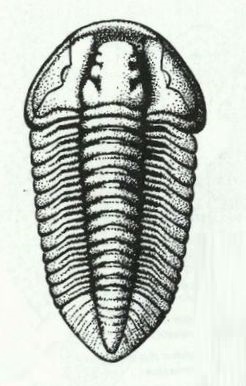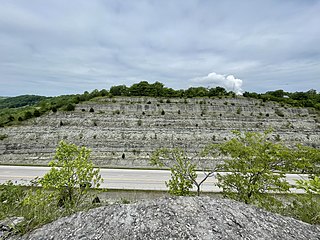The Ordovician is a geologic period and system, the second of six periods of the Paleozoic Era. The Ordovician spans 41.6 million years from the end of the Cambrian Period 485.4 million years ago (Mya) to the start of the Silurian Period 443.8 Mya.

Hallopora is an extinct genus of bryozoans of the family Halloporidae, first identified from the Lower Silurian period. They can be found in Ohio, Indiana, and Kentucky of the Midwestern United States, commonly in the Ordovician Kope Formation.

Flexicalymene Shirley, 1936. is a genus of trilobites belonging to the order Phacopida, suborder Calymenina and Family Calymenidae. Flexicalymene specimens can be mistaken for Calymene, Gravicalymene, Diacalymene and a few other Calymenina genera. They are used as an index fossil in the Ordovician. Ohio and North America are particularly known for being rich with Flexicalymene fossils.

Carbonate hardgrounds are surfaces of synsedimentarily cemented carbonate layers that have been exposed on the seafloor. A hardground is essentially, then, a lithified seafloor. Ancient hardgrounds are found in limestone sequences and distinguished from later-lithified sediments by evidence of exposure to normal marine waters. This evidence can consist of encrusting marine organisms, borings of organisms produced through bioerosion, early marine calcite cements, or extensive surfaces mineralized by iron oxides or calcium phosphates. Modern hardgrounds are usually detected by sounding in shallow water or through remote sensing techniques like side-scan sonar.

The Cincinnati Arch is a broad structural uplift between the Illinois Basin to the west, the Michigan Basin to the northwest and the Appalachian Basin and Black Warrior Basin to the east and southeast. It existed as a positive topographic area during Late Ordovician through the Devonian Period which stretched from northern Alabama northeastward to the southeastern tip of Ontario. Fossils from the Ordovician Period are commonplace in the geologic formations which make up the Cincinnati Arch, and are commonly studied along man made roadcuts. The Nashville Dome of Tennessee and the Jessamine Dome or Lexington Dome of central Kentucky make up the central portion of the Arch. In the northern part, north of Cincinnati, Ohio, the Cincinnati Arch branches to form the Findlay and Kankakee arches. The Findlay plunges under Ontario and reappears as the Algonquin Arch further north.

The Kope Formation is one of the three component bedrock formations of the Maquoketa Group that primarily consists of shale (75%) with some limestone (25%) interbedded. In general, it has a bluish-gray color that weathers light gray to yellowish-gray and it occurs in northern Kentucky, southwest Ohio, and southeast Indiana, United States.

The Queenston Formation is a geological formation of Upper Ordovician age, which outcrops in Ontario, Canada and New York, United States. A typical outcrop of the formation is exposed at Bronte Creek just south of the Queen Elizabeth Way. The formation is a part of the Queenston Delta clastic wedge, formed as an erosional response to the Taconic Orogeny. Lithologically, the formation is dominated by red and grey shales with thin siltstone, limestone and sandstone interlayers. As materials, comprising the clastic wedge, become coarser in close proximity to the Taconic source rocks, siltstone and sandstone layers are predominant in New York.

Trepostomatida is an extinct order of bryozoans in the class Stenolaemata. Trepostome bryozoans possessed mineralized calcitic skeletons and are frequently fossilized; some of the largest known fossilized bryozoan colonies are branching trepostomes and massive dome-shaped trepostomes. Trepostomes did not have many specialized zooecia beyond ordinary feeding autozooecia. The two main known heteromorphs are exilazooecia and mesozooecia, which had the purpose of maintaining regular spacing between autozooecia.

Heterotrypidae is an extinct bryozoan family in the order Trepostomata.

Paleontology in Kentucky refers to paleontological research occurring within or conducted by people from the U.S. state of Kentucky.

Paleontology in Missouri refers to paleontological research occurring within or conducted by people from the U.S. state of Missouri. The geologic column of Missouri spans all of geologic history from the Precambrian to present with the exception of the Permian, Triassic, and Jurassic. Brachiopods are probably the most common fossils in Missouri.
The Lexington Limestone is a prominent geologic formation that constitutes a large part of the late Ordovician bedrock of the inner Bluegrass region in Kentucky. Named after the city of Lexington, the geologic formation has heavily influenced both the surface topography and economy of the region.
The Maquoketa Formation is a geologic formation in Illinois, Indiana. Iowa, Kansas, Minnesota, Missouri, and Wisconsin. It preserves mollusk, coral, brachiopod and graptolite fossils dating back to the Darriwilian to Hirnantian stages of the Ordovician period.
Madeleine Alberta Fritz was a Canadian palaeontologist. She was a professor at the University of Toronto, where she taught vertebrate studies in the department of Geology. Fritz's writing on the fossil Bryozoa along with her research on the stratigraphy of Toronto and the surrounding areas were major contributions to the geological field.
Acanthoceramoporella is an extinct genus of cystoporate bryozoans from the Ordovician period.
Orectodictya is an extinct genus of ptilodictyoid bryozoans known from Ordovician fossils found in the U.S. state of Kentucky. It is monotypic, containing the single species Orectodictya pansa.
Monticulipora is an extinct genus of Ordovician bryozoans belonging to the family Monticuliporidae. It was first named in 1849, and its description was published the following year by French paleontologist Alcide M. d'Orbigny, making it one of the earliest bryozoans to be recognized in science. It is still one of the most widespread fossil bryozoan genera. Though colonies that grow in masses made of multiple layers are characteristic of the genus, its colonies have varying shapes, able to be encrusting, branching, massive, or frond-like, and are covered in monticules (bumps). Most Monticulipora species have distinctively granular walls, and Monticulipora and can be distinguished from Homotrypa by the presence of axial diaphragms.
Hemiphragma is an extinct genus of Middle Ordovician bryozoan. It had branching colonies with thick-walled zooecial apertures and lots of acanthopores, but few mesopores.
Nicholsonella is an extinct genus of bryozoans of uncertain taxonomic placement. Its colonies can take the forms of thick branching masses or branches.

The Maysville roadcut, located in northeastern Kentucky, features Upper Ordovician rock and fossils. Maysville is located in Mason County, Kentucky and contains a large roadcut along the U.S. Route 68 highway. The Maysville roadcut lies on the Clyde T. Barbour Parkway. The roadcut was human-made in the 1950s and consists of rock from the Ordovician period that is roughly 450 million years old. Maysville provides an opportunity to observe the stratigraphy of the formations present of the Ordovician time period.












